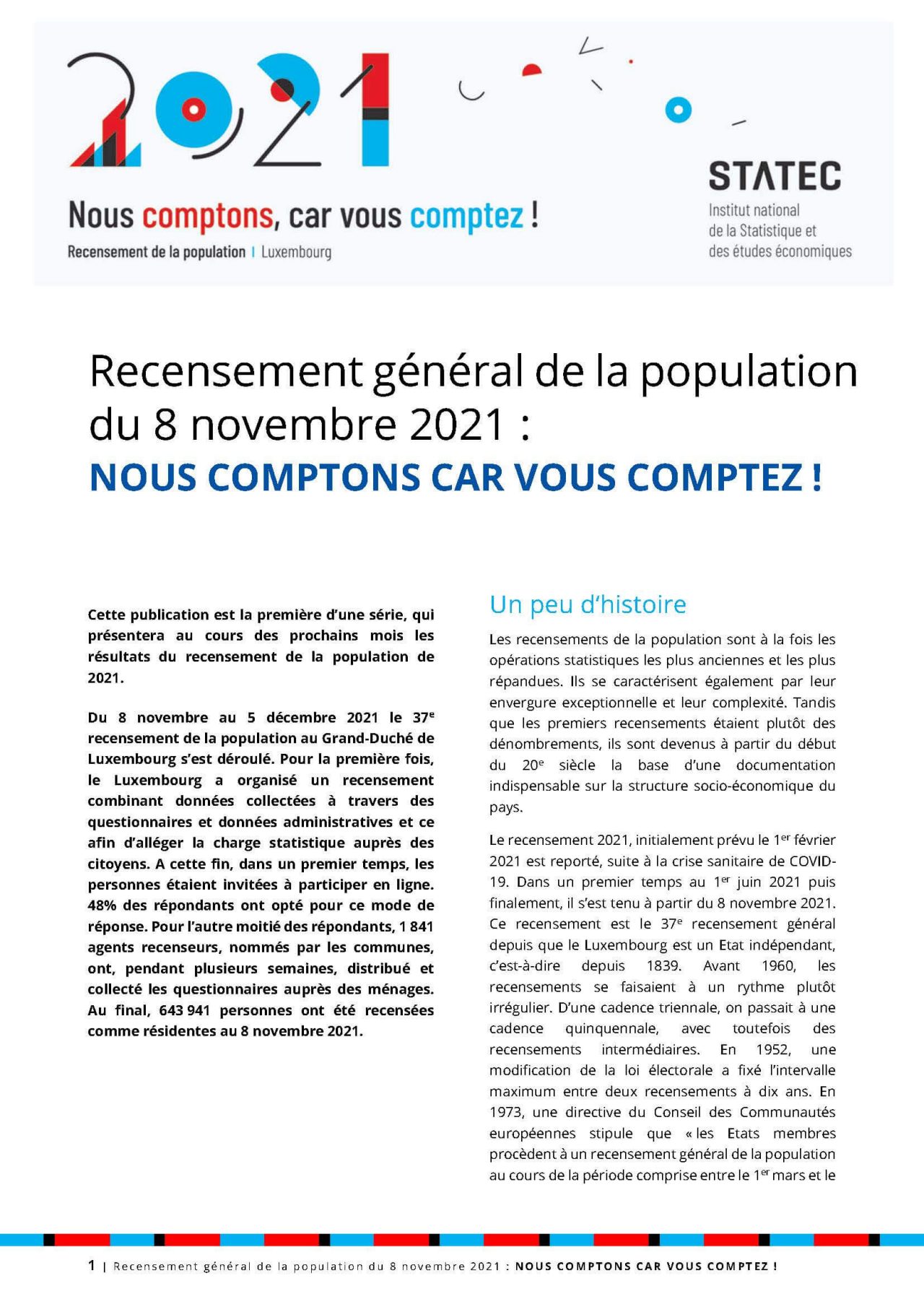History and overview
-
of respondents opted for the online solution for the 2021 population census
48 %
General census of the population: we count
because you count!
This publication is the first in a series, which will present the results of the 2021 population census in the coming months.
The 37e population census in the Grand Duchy of Luxembourg took place from 8 November to 5 December 2021. For the first time, Luxembourg organised a census combining data collected through questionnaires and administrative data to reduce the statistical burden on citizens. To this end, in a first step, people were invited to participate online. 48% of the respondents opted for this method of response. For the other half of the respondents, 1,841 enumerators, appointed by the municipalities, distributed, and collected the questionnaires from households over several weeks.
In the end, 643,941 people were counted as residents on 8 November 2021.
Online participation rate
A little history
Population censuses are both the oldest and most widespread statistical operations. They are also characterised by their exceptional scope and complexity. While the first censuses were more like enumerations, from the beginning of the 20th century onwards they have become the basis for an indispensable documentation on the socio-economic structure of the country.
- 1839: 1st census since the independence of the Grand Duchy of Luxembourg
- 1839 to 1960: Censuses at irregular intervals
- 1952: Law fixing the interval between two censuses at a maximum of 10 years
- 1981: First census organised according to a European Directive
- 2011: Census on 1 February. This census is imposed on the EU-27 Member States by a European Regulation
- 2021: Census on 8 November. This is the 37th census since the country's independence and is also regulated by European legislation
A modernised and attentive service
For the 2021 census, Luxembourg has moved from a so-called "traditional" census, i.e. a census where all the information is collected through questionnaires, to a "combined" census. This new type of census combines data collected through questionnaires with data from various administrative registers: demographic data, sectors of activity for the active population, data on buildings and dwellings.
In 2021, STATEC has modernised both the electronic and paper questionnaires, in terms of design, computer support and presentation of the questions to facilitate the completion and processing of responses.
It was also important to make the participation in the census as easy as possible. To this end, a helpdesk was set up, including a free hotline. From 8 November to 15 December 2021, all citizens could obtain additional information from Monday to Friday, from 8 am to 6 pm. The hotline was a great success, with 9,961 calls.
- Frequency of the free hotline
- Number of e-mails received and processed
Frequency of the free hotline, 8 November to 15 December 2022
In addition to the telephone hotline, STATEC had also set up an e-mail helpdesk. STATEC received a total of 9,119 e-mails. On average, STATEC received 203 e-mails per day between 8 November and mid-December. The peak was reached on 13 December 2021 with 528 mails processed.
Source : STATEC
Number of e-mails received and processed during the 2021 census campaign
Source : STATEC
How are paper questionnaires processed?
After receiving the questionnaires from the 102 municipalities (about 110,000 paper questionnaires), STATEC carried out the first checks on the questionnaires, which consisted of verifying the consistency between certain questions and facilitating the scanning of the questionnaires. Scanning makes it possible to obtain a digital version of the answers, to combine the results with the online questionnaires.
Scanning of paper questionnaires
What was the overall participation rate?
Almost 4 out of 5 people responded to the population census.
The participation rate at national level is around 79%. This rate is slightly lower than for the 2011 census (85% in 2011).
The decline in census participation and the disparities between municipalities can be explained by six main factors:
- Census in the middle of the 4th wave of COVID-19
- Significant challenges in the field work and decreasing involvement of some enumerators
- Non-response of persons who would no longer have their main residence in Luxembourg
- High statistical burden for citizens of a small country like Luxembourg, which might imply less interest in participating
- Technical problems when filling in the questionnaire on Guichet.lu
- New design of the questionnaire with a more commercial character, sometimes not identified as the census.
More results
In the coming months, various publications will be produced for the public, but also for the public specialised in demographic issues. At the same time, statistical tables on the various census topics will be published on the Statistics Portal.
The next publication will present the evolution of the population through the censuses.
Find out more about the history,
facts and figures of the 2021 Census
Why is the census important?
Census results are essential information for public policy decision-making.
Census data help to forecast needs for land use planning, schools, nurseries, hospitals, retirement and nursing homes, housing, etc.
Last update


